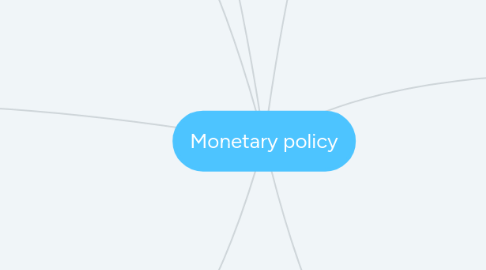
1. Expansionary monetary policy
1.1. focused on expanding money supply in market
1.1.1. how?
1.1.1.1. by lowering key interest rates thus increasing market liquidity
2. Contractionary monetary policy
2.1. focused on contrcating money supply
2.1.1. by increasing key interest rates thus reducing market liquidity
3. RBI mandated through RBI act 1934
3.1. Recently formed Monetary Policy Framework (MPF), Monetary Policy Committee (MPC), and Monetary Policy Process (MPP)
3.1.1. Monetary policy framework
3.1.1.1. aims at setting the policy (repo) rate
3.1.1.2. Repo rate changes transmit through the money market to the entire financial system
3.1.1.3. Reserve Bank envisages liquidity management on a day-to-day basis
3.1.2. Monetary Policy Committee (MPC)
3.1.2.1. policy interest rate required to achieve the inflation target is decided by the Monetary Policy Committee
3.1.2.2. MPC is a six-member committee constituted by the Central Government
3.1.2.3. MPC is required to meet at least four times a year
3.1.2.4. Once in every six months, the Reserve Bank is required to publish a document called the Monetary Policy Report to explain: (1) the sources of inflation and(2) the forecast of inflation for 6-18 months ahead.
3.1.3. Monetary policy Process
3.1.3.1. The Reserve Bank’s Monetary Policy Department (MPD) assists the MPC in formulating the monetary policy.
3.1.3.2. The Financial Markets Operations Department (FMOD) operationalises the monetary policy
3.1.3.3. The Financial Market Committee (FMC) meets daily to review the liquidity conditions.
4. Main goal of Monetary Policy
4.1. Maintain price stability
5. What is it?
5.1. Policy adopted by central bank to check Interest rates, Money supply and Availability of credits.
5.1.1. Why?
5.1.1.1. To control inflation in the country
6. Flexible Inflation Targeting Framework
6.1. what is it?
6.1.1. Publicly announced inflation target by the government in consultation with RBI for five years.
6.1.2. Current Inflation target is around 4%
6.1.2.1. tolerance of up to 6% at the highest and 2% at the lowest
6.1.2.2. Failures if: for three consecutive quarters there is a upper tolerance level of Inflation target.
6.1.2.3. Failure if: Average inflation is less than lower tolerance level for three consecutive quarters.
